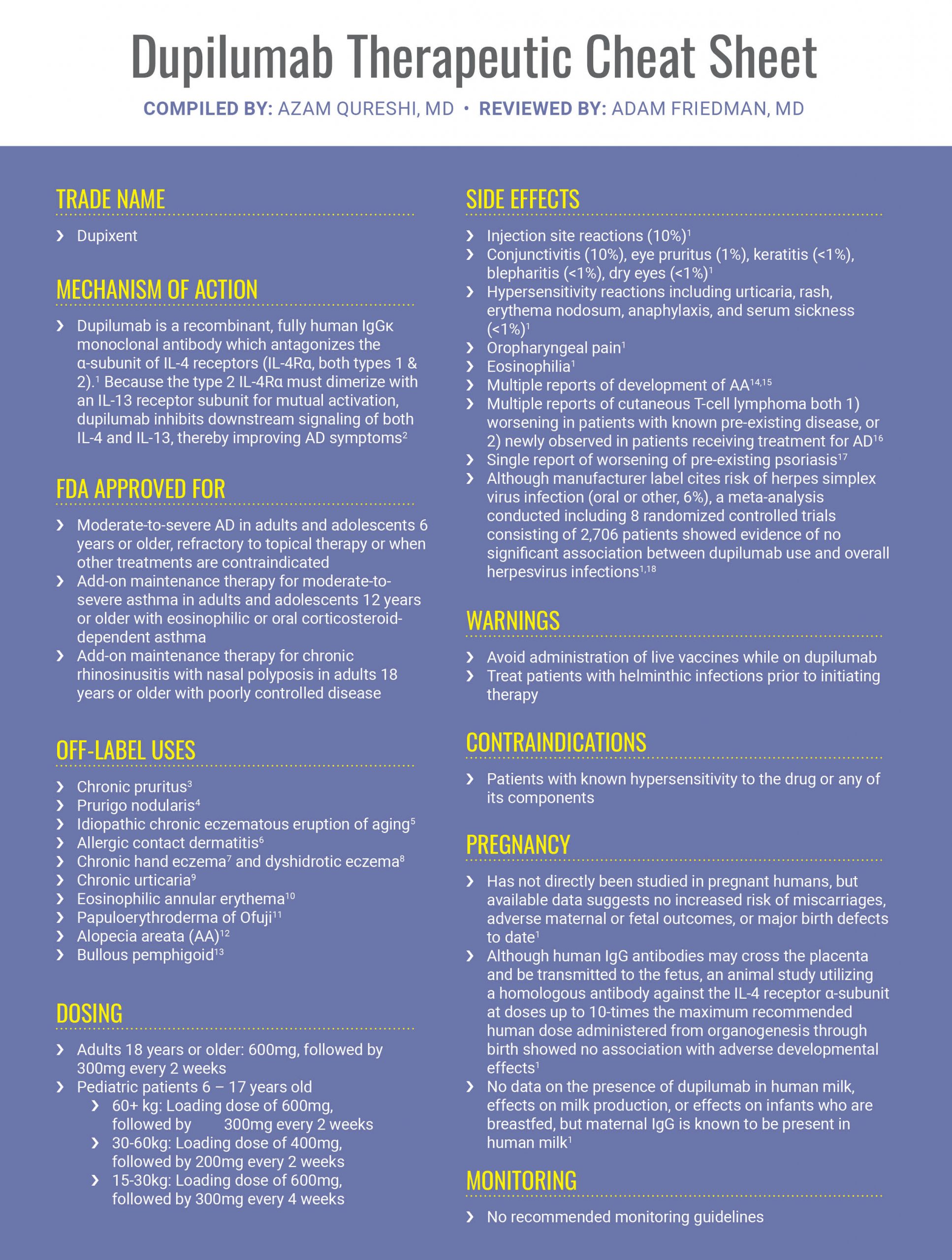Atopic dermatitis (AD) is a common skin condition characterized by pruritus and occurs as a result of factors related to impaired skin barrier and immune response, as well as environmental and infectious agents. Patients with poor control on topical therapy are looking for safe and effective systemic treatments. We continue our series, Therapeutic Cheat Sheet, with a closer look at dupilumab, which is not only utilized effectively in the treatment of AD, but also carries a growing amount of evidence to support its off-label use for multiple skin conditions.
TRADE NAME
-
- Dupixent
MECHANISM OF ACTION
-
- Dupilumab is a recombinant, fully human IgGκ monoclonal antibody which antagonizes the α-subunit of IL-4 receptors (IL-4Rα, both types 1 & 2).1 Because the type 2 IL-4Rα must dimerize with an IL-13 receptor subunit for mutual activation, dupilumab inhibits downstream signaling of both IL-4 and IL-13, thereby improving AD symptoms2
FDA APPROVED FOR
-
- Moderate-to-severe AD in adults and adolescents 6 years or older, refractory to topical therapy or when other treatments are contraindicated
- Add-on maintenance therapy for moderate-to-severe asthma in adults and adolescents 12 years or older with eosinophilic or oral corticosteroid-dependent asthma
- Add-on maintenance therapy for chronic rhinosinusitis with nasal polyposis in adults 18 years or older with poorly controlled disease
OFF-LABEL USES
-
- Chronic pruritus3
- Prurigo nodularis4
- Idiopathic chronic eczematous eruption of aging5
- Allergic contact dermatitis6
- Chronic hand eczema7 and dyshidrotic eczema8
- Chronic urticaria9
- Eosinophilic annular erythema10
- Papuloerythroderma of Ofuji11
- Alopecia areata (AA)12
- Bullous pemphigoid13
DOSING
-
- Adults 18 years or older: 600mg, followed by 300mg every 2 weeks
- Pediatric patients 6 – 17 years old
- 60+ kg: Loading dose of 600mg, followed by 300mg every 2 weeks
- 30-60kg: Loading dose of 400mg, followed by 200mg every 2 weeks
- 15-30kg: Loading dose of 600mg, followed by 300mg every 4 weeks
SIDE EFFECTS
-
- Injection site reactions (10%)1
- Conjunctivitis (10%), eye pruritus (1%), keratitis (<1%), blepharitis (<1%), dry eyes (<1%)1
- Hypersensitivity reactions including urticaria, rash, erythema nodosum, anaphylaxis, and serum sickness (<1%)1
- Oropharyngeal pain1
- Eosinophilia1
- Multiple reports of development of AA14,15
- Multiple reports of cutaneous T-cell lymphoma both 1) worsening in patients with known pre-existing disease, or 2) newly observed in patients receiving treatment for AD16
- Single report of worsening of pre-existing psoriasis17
- Although manufacturer label cites risk of herpes simplex virus infection (oral or other, 6%), a meta-analysis conducted including 8 randomized controlled trials consisting of 2,706 patients showed evidence of no significant association between dupilumab use and overall herpesvirus infections1,18
WARNINGS
-
- Avoid administration of live vaccines while on dupilumab
- Treat patients with helminthic infections prior to initiating therapy
CONTRAINDICATIONS
-
- Patients with known hypersensitivity to the drug or any of its components
PREGNANCY
-
- Has not directly been studied in pregnant humans, but available data suggests no increased risk of miscarriages, adverse maternal or fetal outcomes, or major birth defects to date1
- Although human IgG antibodies may cross the placenta and be transmitted to the fetus, an animal study utilizing a homologous antibody against the IL-4 receptor α-subunit at doses up to 10-times the maximum recommended human dose administered from organogenesis through birth showed no association with adverse developmental effects1
- No data on the presence of dupilumab in human milk, effects on milk production, or effects on infants who are breastfed, but maternal IgG is known to be present in human milk1
MONITORING
-
- No recommended monitoring guidelines
Dupilumab has changed the landscape of AD therapy since its initial FDA-approval in March of 2017, proving to be a safe and effective systemic treatment option for patients with AD.19 An accumulating amount of studies also support its use in a variety of off-label applications, from chronic hand eczema to bullous pemphigoid. Practitioners should continue to take note of newly published reports concerning the safety of this medication in the diversity of clinical settings in which it is utilized.
CLICK ON THE IMAGE BELOW TO DOWNLOAD YOUR THERAPEUTIC CHEAT SHEET
FURTHER READING
If you would like to learn more about dupilumab, check out the following 2 articles published in the Journal of Drugs in Dermatology:
Dupilumab in Dermatology: Potential for Uses Beyond Atopic Dermatitis
Nolan J. Maloney BS, Kyle Tegtmeyer BS, Jeffrey Zhao BA, Scott Worswick MD
Abstract:
Dupilumab inhibits the interleukin-4 receptor subunit α and is FDA approved for treatment of moderate-to-severe atopic dermatitis. It is a relatively new drug, and whether it is efficacious for other diseases in dermatology is an area of increasing interest. We searched the literature and ClinicalTrials.gov database for uses of dupilumab beyond atopic dermatitis in dermatology and for ongoing studies on new uses for dupilumab. Off-label reports identified described use of dupilumab for several different dermatologic conditions, including allergic contact dermatitis, hand dermatitis, chronic spontaneous urticaria, prurigo nodularis, and alopecia areata. Overall, there is limited but promising data for dupilumab use beyond atopic dermatitis in dermatology. The relatively safe adverse effect profile of dupilumab may make it an option for certain recalcitrant diseases in dermatology, but further studies will be needed to assess its efficacy and determine its best possible use. Read the full article here.
Dupilumab Treatment for Prurigo Nodularis and Pruritis
Ross Tanis MD MS, Katalin Ferenczi MD, Michael Payette MD MBAB
Abstract:
Prurigo nodularis (PN) is a disease in which chronic scratching and picking of the skin due to intense pruritis results in papulonodules, notably in areas that are accessible to the patient. The pathophysiology is hypothesized to be mediated by a Th2 helper cell response, similar to that seen in atopic dermatitis, therefore, treatment of PN with dupilumab would be expected to elicit a therapeutic response. We demonstrated that treatment of PN with dupilumab significantly decreased pruritis and the size and number of new lesions after 2 months of treatment. Read the full article here.
References
-
- Regeneron Pharmaceuticals Inc: DUPIXENT® (dupilumab) injection, for subcutaneous use. Package Insert. US Prescribing Information and Patient Information. Revised 2020 Available at https://www.regeneron.com/sites/default/files/Dupixent_FPI.pdf
- Murata T, Obiri NI, Puri RK. Structure of and signal transduction through interleukin-4 and interleukin-13 receptors. International journal of molecular medicine. 1998 Mar 1;1(3):551-8.
- Zhai LL, Savage KT, Qiu CC, Jin A, Valdes-Rodriguez R, Mollanazar NK. Chronic pruritus responding to dupilumab—a case series. Medicines. 2019 Sep;6(3):72.
- Rambhia PH, Levitt JO. Recalcitrant prurigo nodularis treated successfully with dupilumab. JAAD case reports. 2019 May 1;5(5):471-3.
- Shahriari N, Strober B, Shahriari M. The role of dupilumab in the management of idiopathic chronic eczematous eruption of aging. Journal of the American Academy of Dermatology. 2020 Nov 1;83(5):1533-5.
- Goldminz AM, Scheinman PL. A case series of dupilumab‐treated allergic contact dermatitis patients. Dermatologic therapy. 2018 Nov;31(6):e12701.
- Oosterhaven JA, Voorberg AN, Romeijn GL, de Bruin‐Weller MS, Schuttelaar ML. Effect of dupilumab on hand eczema in patients with atopic dermatitis: an observational study. The Journal of dermatology. 2019 Aug;46(8):680-5.
- Weston GK, Hooper J, Strober BE. Dupilumab in the Treatment of Dyshidrosis: A Report of Two Cases. Journal of drugs in dermatology: JDD. 2018 Mar 1;17(3):355-6.
- Lee JK, Simpson RS. Dupilumab as a novel therapy for difficult to treat chronic spontaneous urticaria. The journal of allergy and clinical immunology. In practice. 2019;7(5):1659-61.
- Gordon SC, Robinson SN, Abudu M, Her M, Deverapalli S, Levin A, Schmidt BA, Gellis SE, Rosmarin D. Eosinophilic annular erythema treated with dupilumab. Pediatric dermatology. 2018 Jul;35(4):e255-6.
- Teraki Y, Taguchi R, Takamura S, Fukuda T. Use of dupilumab in the treatment of papuloerythroderma of ofuji. JAMA dermatology. 2019 Aug 1;155(8):979-80.
- Harada K, Irisawa R, Ito T, Uchiyama M, Tsuboi R. The effectiveness of dupilumab in patients with alopecia areata who have atopic dermatitis: a case series of seven patients. British Journal of Dermatology. 2020 Aug;183(2):396-7.
- Abdat R, Waldman RA, de Bedout V, Czernik A, Mcleod M, King B, Gordon S, Ahmed R, Nichols A, Rothe M, Rosmarin D. Dupilumab as a novel therapy for bullous pemphigoid: a multicenter case series. Journal of the American Academy of Dermatology. 2020 Jul 1;83(1):46-52.
- Mitchell K, Levitt J. Alopecia areata after dupilumab for atopic dermatitis. JAAD case reports. 2018 Mar 1;4(2):143-4.
- Yazdanyar S, Jemec GB. Alopecia areata after treatment with dupilumab. Dermatitis. 2019 Mar 1;30(2):175-6.
- Espinosa ML, Nguyen MT, Aguirre AS, Martinez-Escala ME, Kim J, Walker CJ, Pontes DS, Silverberg JI, Choi J, Pro B, Pincus LB. Progression of cutaneous T-cell lymphoma after dupilumab: Case review of 7 patients. Journal of the American Academy of Dermatology. 2020 Jul 1;83(1):197-9.
- Tracey EH, Elston C, Feasel P, Piliang M, Michael M, Vij A. Erythrodermic presentation of psoriasis in a patient treated with dupilumab. JAAD case reports. 2018 Aug 1;4(7):708-10.
- Fleming P, Drucker AM. Risk of infection in patients with atopic dermatitis treated with dupilumab: a meta-analysis of randomized controlled trials. Journal of the American Academy of Dermatology. 2018 Jan 1;78(1):62-9.
- Guttman-Yassky E, Bissonnette R, Ungar B, Suárez-Fariñas M, Ardeleanu M, Esaki H, Suprun M, Estrada Y, Xu H, Peng X, Silverberg JI. Dupilumab progressively improves systemic and cutaneous abnormalities in patients with atopic dermatitis. Journal of Allergy and Clinical Immunology. 2019 Jan 1;143(1):155-72.
- Maloney NJ, Tegtmeyer K, Zhao J, Worswick S. Dupilumab in dermatology: potential for uses beyond atopic dermatitis. Journal of drugs in dermatology: JDD. 2019 Oct 1;18(10).
- Tanis R, Ferenczi K, Payette M. Dupilumab treatment for prurigo nodularis and pruritis. Journal of drugs in dermatology: JDD. 2019 Sep 1;18(9):940-2.
Did you enjoy this therapeutic cheat sheet? You can find more here.


